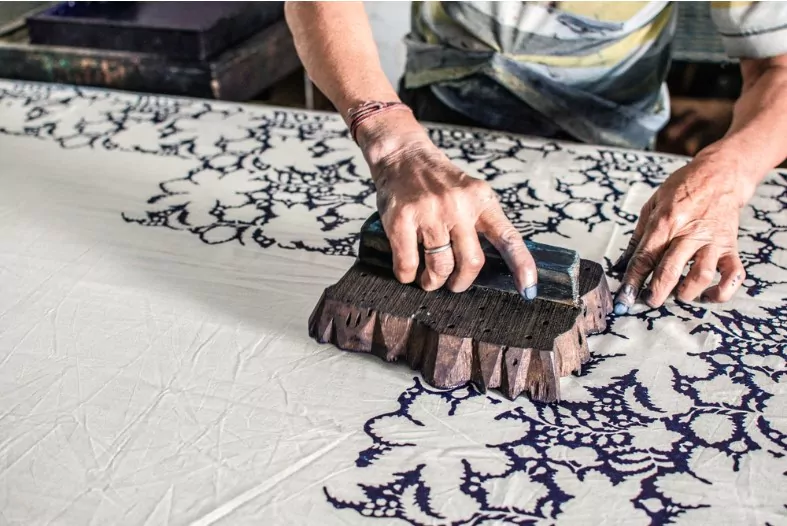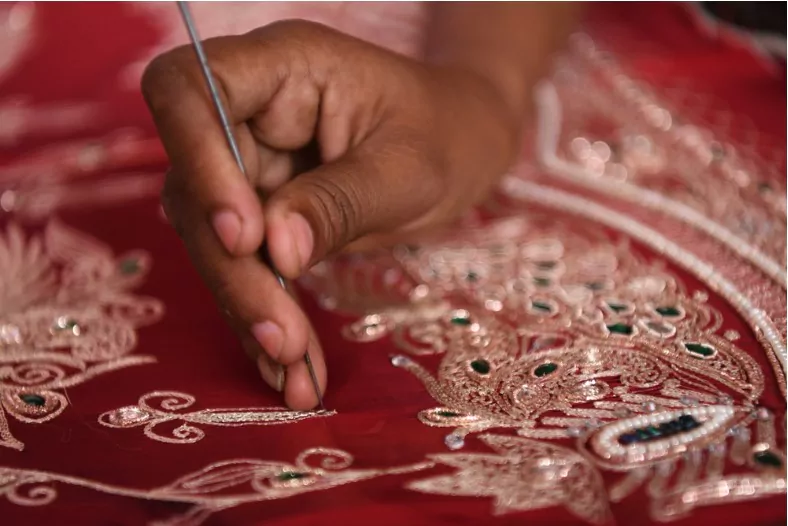Experiencing the Richness of Fabrics of Rajasthan

From the sand-swept dunes to the majestic palaces, the state of Rajasthan in India is an intriguing paradox of simplicity and grandeur. Known for its rich cultural heritage, Rajasthan is particularly famous for its textiles, a multifaceted array of patterns, colours, and techniques that are as diverse and vibrant as the land itself. The fabulous fabrics of Rajasthan are globally appreciated for their remarkable resilience, vivid colors, intricate designs, and the inherent stories of centuries-old traditions.
Rajasthan textiles showcase a compelling blend of skills passed down over generations, and each weave or print is a testament to the region’s historic prowess in textile design. The multitude of textiles from Rajasthan reflects the state’s geographical variety and cultural diversity. Their creation process involves a unique fusion of traditional methods and artistic creativity, resulting in a fascinating array of fabrics that appeal to both traditional and contemporary tastes.
- The Magnificence of Block Printing
- The Intricacy of Bandhani and Leheriya
- The Exuberance of Embroidery
- The Resilience of Khadi and Woollen Textiles
- Sustainable Future with Natural Dyes
- Shopping for Rajasthan Textiles
- Rajasthan Textiles as a Fashion Statement
- The Influence of Royal Heritage
- Traditional Crafts and Empowerment
- Wrapping Up
1 The Magnificence of Block Printing

One of the most iconic elements of Rajasthan textiles is the art of block printing. This ancient technique, used for centuries by local artisans, involves carving patterns onto wooden blocks, which are then dipped in dye and stamped onto the fabric. Ajrakh, Bagru, Dabu, and Sanganeri are among the famous block print styles that the fabrics of Rajasthan are known for. Each design is unique and symbolises different aspects of Rajasthan’s rich history and culture. For instance, Sanganeri prints often feature floral and nature-inspired designs in vibrant colours, capturing the region’s natural beauty and biodiversity.
2 The Intricacy of Bandhani and Leheriya

Another defining feature of the textiles of Rajasthan is the bandhani or bandhej technique, a traditional method of tie-dye where the fabric is tightly tied at several points before dyeing, creating an array of geometric patterns or dots. The leheriya technique is a variant of tie-dye, in which the cloth is rolled diagonally and then dyed, producing beautiful wave-like designs reminiscent of the state’s undulating sand dunes.
3 The Exuberance of Embroidery

Rajasthan is also home to exquisite embroidery styles, each with its own characteristic motifs and techniques. Embroidery styles like Aari, Zardosi, Gota Patti, and Mirror work embellish fabrics, often adding a touch of luxury to the humblest of textiles. Gota Patti, a popular form of applique technique using gold and silver ribbons, is widely seen on the bridal trousseau in Rajasthan, making the fabrics an integral part of the state’s wedding culture.
4 The Resilience of Khadi and Woollen Textiles
The fabrics of Rajasthan are not just about ornamental finesse, but also about rugged practicality. Khadi, hand-spun and hand-woven cotton was a fabric that became a symbol of resistance during India’s struggle for independence. In Rajasthan, Khadi is still spun on traditional charkhas (spinning wheels) and woven into a durable, breathable fabric. Similarly, woollen textiles from Rajasthan, such as the Pattu shawls and Loi blankets woven by the pastoral communities, are known for their exceptional warmth and hardiness.
5 Sustainable Future with Natural Dyes
What makes Rajasthan textiles even more remarkable is the use of natural dyes, an element that adds not just colour but also eco-friendliness to the fabrics of Rajasthan. The age-old practice of using plant-based dyes made from indigo, turmeric, pomegranate, and madder roots is getting renewed attention, helping mitigate synthetic dyes’ environmental impact while preserving traditional techniques.
6 Shopping for Rajasthan Textiles
For those keen to acquire some Rajasthan textiles, the bustling markets of Jaipur, Udaipur, Jodhpur, and other cities in the state offer a bewildering range of choices. Famous markets like Johari Bazaar in Jaipur, Clock Tower Market in Jodhpur, and Bada Bazaar in Udaipur are veritable treasure troves for textile lovers, offering everything from block-printed bed linen to embroidered apparel and tie-dyed scarves.
7 Rajasthan Textiles as a Fashion Statement
Today, the fabrics of Rajasthan have transcended beyond the realm of traditional attire and are making a bold fashion statement on the global stage. Designers around the world are increasingly incorporating vibrant Rajasthan textiles into their collections, introducing these traditional fabrics to a whole new audience. The brilliant hues, intricate patterns, and unique motifs of the Rajasthan fabrics add an exotic touch to contemporary fashion, making them a favourite choice for both everyday wear and high-fashion couture.
In addition, home decor enthusiasts and interior designers are incorporating the textiles of Rajasthan into their designs, creating a fusion of modern aesthetics and traditional artistry. Be it the vibrant Bandhani curtains or the block-printed throw pillows, each element adds a unique touch of Rajasthan’s colourful heritage to homes and spaces worldwide.
8 The Influence of Royal Heritage

The royal heritage of Rajasthan has played a significant role in shaping the textile industry. The royal families were patrons of arts and crafts, leading to the creation of some exquisite pieces that are still revered today. The grandeur and opulence of the royal courts are reflected in the rich fabrics like brocades, silks, and velvets, adorned with intricate gold and silver thread work known as ‘zari’. These royal textiles, once exclusive to the palaces of Rajasthan, are now accessible to the world, adding a regal touch to anyone who dons them.
9 Traditional Crafts and Empowerment
The traditional textile crafts of Rajasthan also contribute to social and economic empowerment. Many cooperatives and non-profit organisations work with rural artisans, particularly women, to help them hone their skills and find a market for their products. This not only helps preserve traditional crafts but also provides a sustainable source of income for these artisans, empowering them and their communities.
The practice of traditional crafts also fosters a sense of pride and identity among the artisans. Each handwoven fabric, each hand-dyed garment, is a testament to their skill, patience, and creativity, making the textiles of Rajasthan more than just a product, but a celebration of human ingenuity.
10 Wrapping Up
In conclusion, the fabrics of Rajasthan are an enduring testament to the state’s rich cultural heritage, artistic ingenuity, and traditional skills. They are a vital part of the state’s identity, painting a vivid picture of the land, its people, and their stories. Whether it’s the intricacy of the block prints, the vibrancy of the tie-dyes, the richness of the embroideries, or the ruggedness of the Khadi and woollen textiles, each fabric speaks a language of beauty, resilience, and tradition that resonates far beyond the borders of this desert state.
While the future brings new challenges, the commitment to preserving and promoting the age-old textiles of Rajasthan ensures that these fabrics will continue to enchant and inspire generations to come. Through sustainable practices like natural dyeing and support for artisanal skills, the story of Rajasthan’s textile tradition is being carried forward, adding new threads to a tapestry that has been woven over centuries.
The fabrics of Rajasthan, with their unique blend of history, culture, and artistry, are not just textiles; they are tangible narratives of a vibrant and resilient community, waiting to be cherished and celebrated.
Community Q&A
About This Article
This article has been viewed 428 times.



